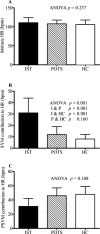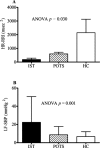Postural tachycardia syndrome and inappropriate sinus tachycardia: role of autonomic modulation and sinus node automaticity
- PMID: 24721800
- PMCID: PMC4187519
- DOI: 10.1161/JAHA.113.000700
Postural tachycardia syndrome and inappropriate sinus tachycardia: role of autonomic modulation and sinus node automaticity
Abstract
Background: Inappropriate sinus tachycardia (IST) and postural tachycardia syndrome (POTS) are 2 disorders characterized by sinus tachycardia. It is debated whether the pathophysiology of IST and POTS results from abnormal autonomic regulation or abnormal sinus node function. We hypothesized that intrinsic heart rate (IHR) after autonomic blockade would be increased in patients with IST but not POTS.
Methods and results: We enrolled 48 POTS patients, 8 IST patients, and 17 healthy control (HC) subjects. Intravenous propranolol and atropine were given to block the sympathetic and parasympathetic limbs of the autonomic nervous system in order to determine the IHR. Patients with IST have a higher sympathetic contribution to heart rate when compared with POTS patients (31±13 bpm versus 12±7 bpm, P<0.001) and HC (8±4 bpm; P<0.001) and a trend to less parasympathetic contribution than POTS and HC (IST: 31±11 bpm versus POTS: 46±11 bpm versus HC: 48±11 bpm, ANOVA P=0.108). IHR was not significantly different between IST and either POTS or HC (IST: 111±11 bpm versus POTS: 108±11 bpm versus HC: 106±12 bpm, ANOVA P=0.237).
Conclusions: IST patients have more sympathetic tone when compared with either POTS or HC, but IST patients do not have abnormal sinus node automaticity. These data suggest that the treatment of IST and POTS should focus on sympatholysis, reserving sinus node modification for patients with continued debilitating symptoms after beta-blockade and possibly ivabradine.
Clinical trial registration url: http://clinicaltrials.gov/. Unique identifier: NCT00262470.
Keywords: autonomic nervous system; inappropriate sinus tachycardia; postural tachycardia syndrome; sinus node; sympathetic nervous system.
Figures




References
-
- Brady PA, Low PA, Shen WK. Inappropriate sinus tachycardia, postural orthostatic tachycardia syndrome, and overlapping syndromes. Pacing Clin Electrophysiol. 2005; 28:1112-1121 - PubMed
-
- Shen WK, Low PA, Jahangir A, Munger TM, Friedman PA, Osborn MJ, Stanton MS, Packer DL, Rea RF, Hammill SC. Is sinus node modification appropriate for inappropriate sinus tachycardia with features of postural orthostatic tachycardia syndrome? Pacing Clin Electrophysiol. 2001; 24:217-230 - PubMed
-
- Morillo CA, Klein GJ, Thakur RK, Li H, Zardini M, Yee R. Mechanism of ‘inappropriate’ sinus tachycardia. Role of sympathovagal balance. Circulation. 1994; 90:873-877 - PubMed
-
- Olshansky B, Sullivan RM. Inappropriate sinus tachycardia. J Am Coll Cardiol. 2013; 61:793-801 - PubMed
-
- Bauernfeind RA, Amat YL, Dhingra RC, Kehoe R, Wyndham C, Rosen KM. Chronic nonparoxysmal sinus tachycardia in otherwise healthy persons. Ann Intern Med. 1979; 91:702-710 - PubMed
Publication types
MeSH terms
Substances
Associated data
Grants and funding
LinkOut - more resources
Full Text Sources
Other Literature Sources
Medical

